Food is a huge part of travel. It’s tied to history and culture, and when we travel part of the way we experience another country is through what we eat.
So what’s that got to do with scones?
Well, scones are my grandmother’s speciality. I’ve watched her make them countless times over the years as I grew up in New Zealand. Whenever there was a family occasion, my Grandma would make scones.
The scone recipe is so ingrained in her that she doesn’t even use measurements anymore and does it all by muscle memory, look, and feel.
Whenever I bought scones out in cafes, I was always disappointed because they weren’t as good as my Grandma’s! And it’s not just me; my Grandma won competitions with her scones too.
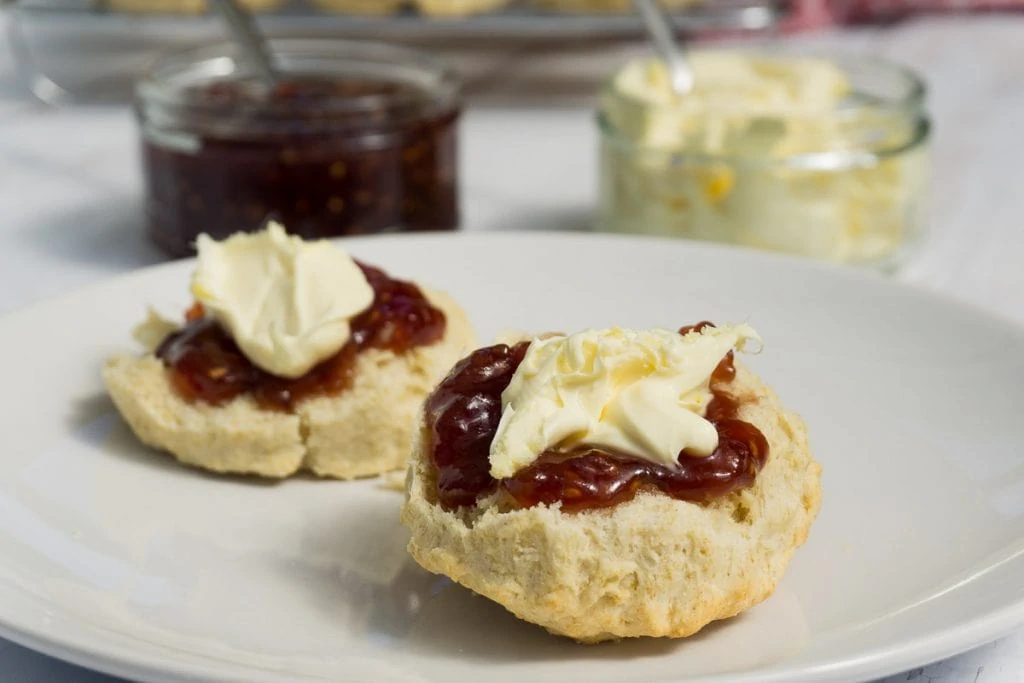
Then I moved to Scotland.
Scones are big here, literally and figuratively. In my early days of cafe hunting in Edinburgh, I came across them almost everywhere I went, alongside treats like Old School Cake, Mars Bar Slice, Chocolate Tiffin, and Mint Aero Traybake.
But I stuck to what I knew, and it became usual for me to get the soup of the day, followed by a big, delicious scone. I know I’m not alone as I see many travellers get hooked on Scottish Scones too.
Scones are popular all over the UK, especially as part of afternoon tea, but I seem to associate them more with Scotland since I moved here! Most of the Scottish scones I’ve had are pretty good, although I still sometimes miss a good batch from my Grandma.
Pin for Later!
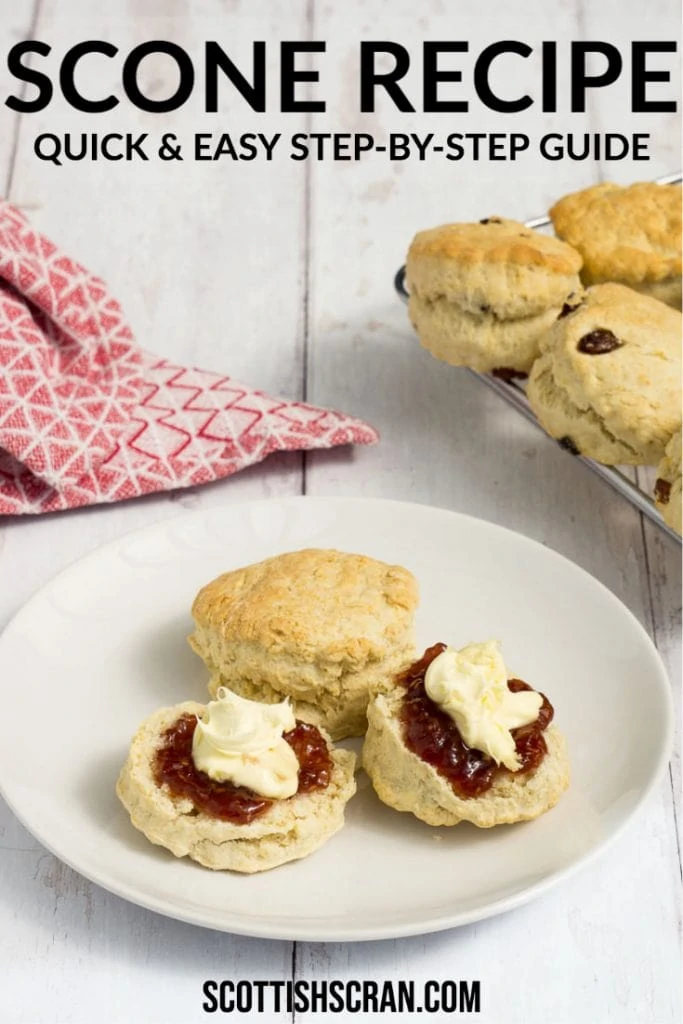
Are Scones Scottish?
There are actually some who would claim that scones were invented in Scotland!
The first mention of them is in a book translated by a Scottish poet in 1513, and some even say they were named after the Stone of Destiny, also called the Stone of Scone, after where it was kept in Scone Abbey near Scone in Scotland. Sensing a theme there…
In any case, scones remind me of New Zealand, thanks to my Grandma and Scotland. So when I was speaking to my Grandma recently, I decided to take a little trip down memory lane and get her scone recipe, in the hopes of being able to re-create them for myself.
This wasn’t as easy as you might think, and involved me holding up a block of butter and milk and her estimating how much she would use. But we got there in the end!
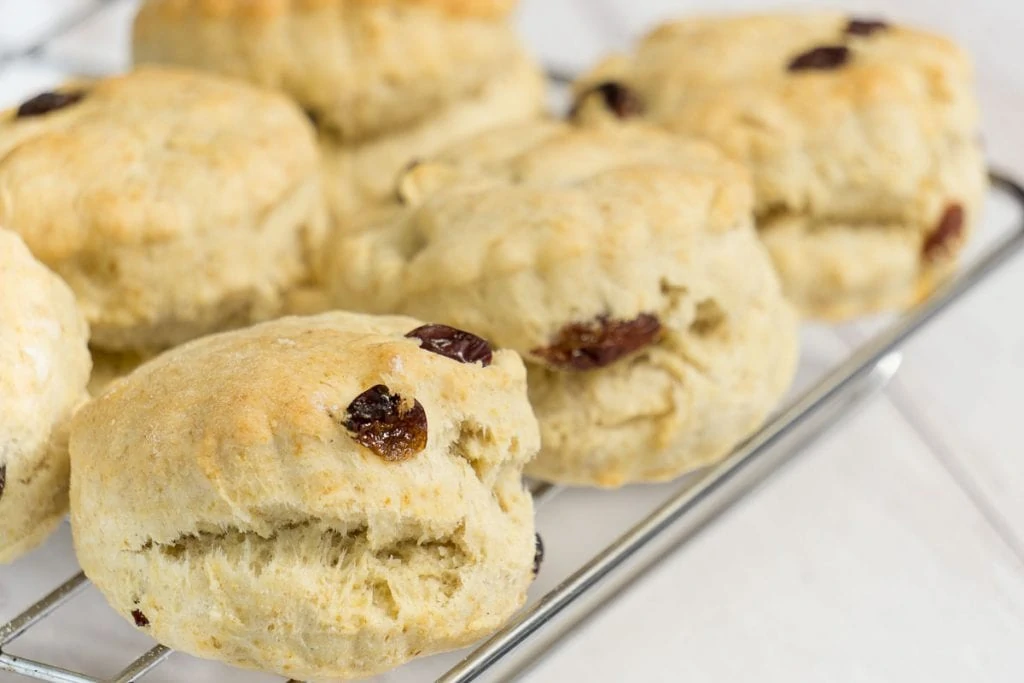
What’s the difference between Scones and Biscuits?
I know many of you are side-eyeing me with this question because if biscuits to you are a sweet snack that comes in many varieties, you’re wondering how on earth I could confuse one with a scone.
But when I moved to the USA, I was introduced to their version of “biscuits”, which incidentally looked somewhat like a scone. Except they cover them in sausage gravy…
So for those of you wondering what a scone is (looking at you, Americans!), it’s basically like a biscuit.
When I was looking up the difference, many websites mentioned that scones have eggs in them, which isn’t true. I’ve never made a scone with egg in it before! Maybe some do, but I wouldn’t say it’s a common traditional scone recipe.
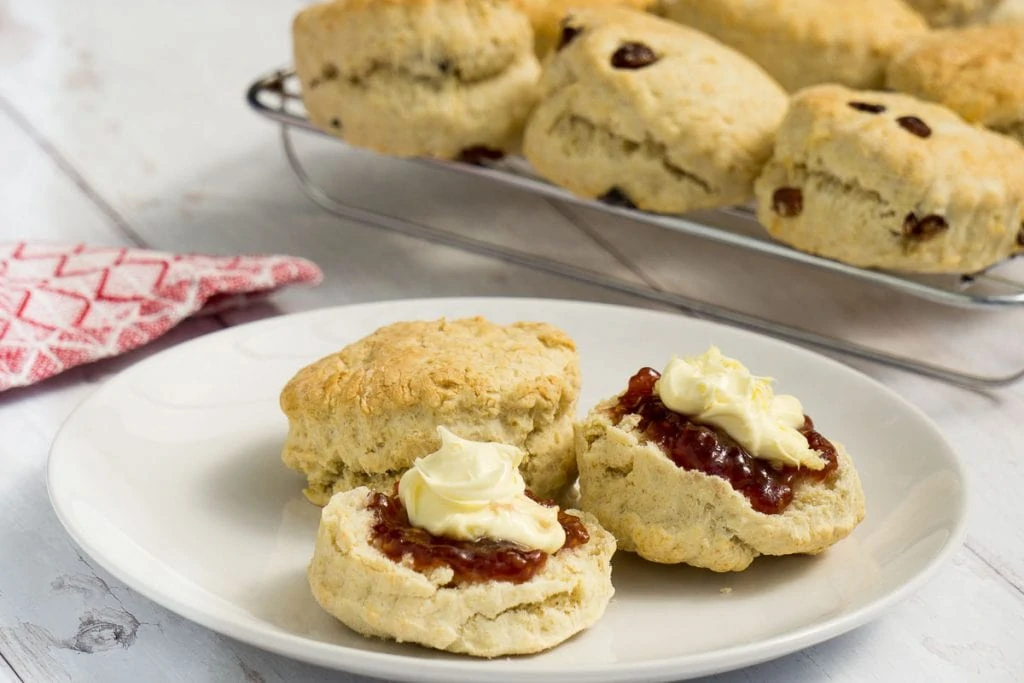
It seems like the difference is more in the fat or sugar content. I’ve also never used sugar in a scone although some people might, scones do have almost twice the amount of butter as a biscuit.
They’re also usually served with jam, cream, or butter (or all three!), unless they’re specifically a savoury scone, like the cheese scone popular in New Zealand. In the USA biscuits are usually served with a gravy or savoury dishes, more like a bread.
Anyway, if you feel like indulging in a bit of British baking, making scones is a great idea! They’re fairly simple and don’t use too many ingredients.
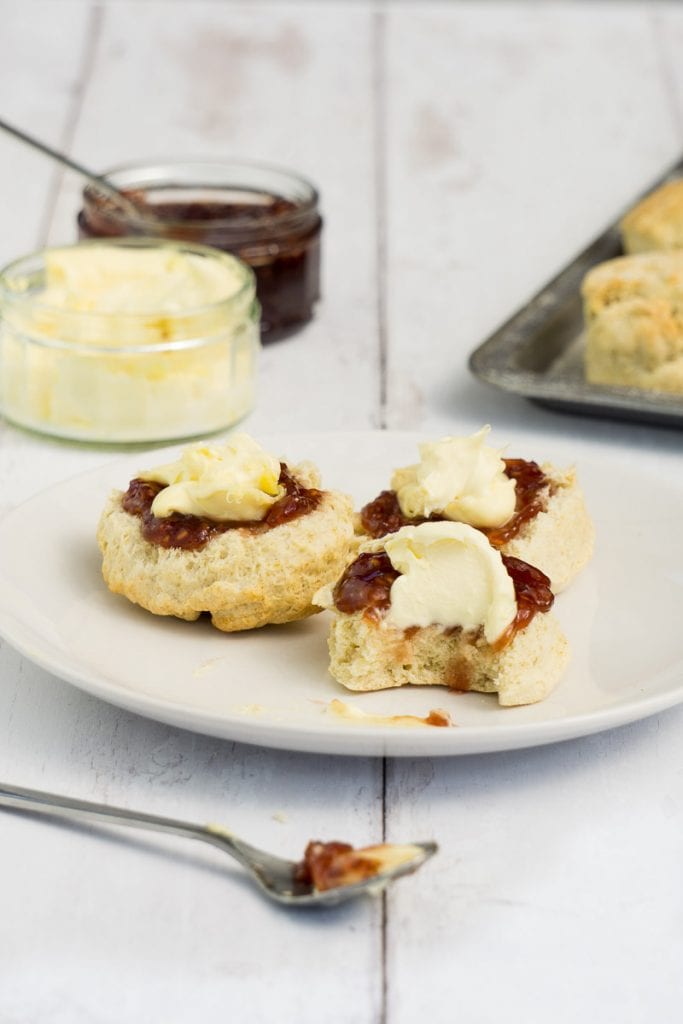
So here we go! I’ve laid out some tips for making this recipe with step-by-step photos and the full instructions underneath.
Making this Easy Scone Recipe
I took some photos as I made my latest batch so that you can see a step-by-step scone recipe and what it should look like at each stage. I’ve also included a few more tips!
When sifting the flour and baking powder into a bowl, my Grandma said you could use 4 “good” cups, as in don’t worry about levelling them off too precisely. I use baking powder although I do use self-raising flour which technically already has a rising agent in it.
You have to get your hands dirty when it comes to rubbing the butter into the flour. You can use some tools to help get the butter and the flour mixed together, like a pastry cutter/blender, but you’ll still likely need to use your hands.
DON’T MELT THE BUTTER. It’s tempting to think you can melt it and mix it in, but it doesn’t work. You can take the butter out of the fridge to let it soften up a bit; otherwise, you’ll need to cut it really finely in, or even grate it if it’s hard from the fridge.
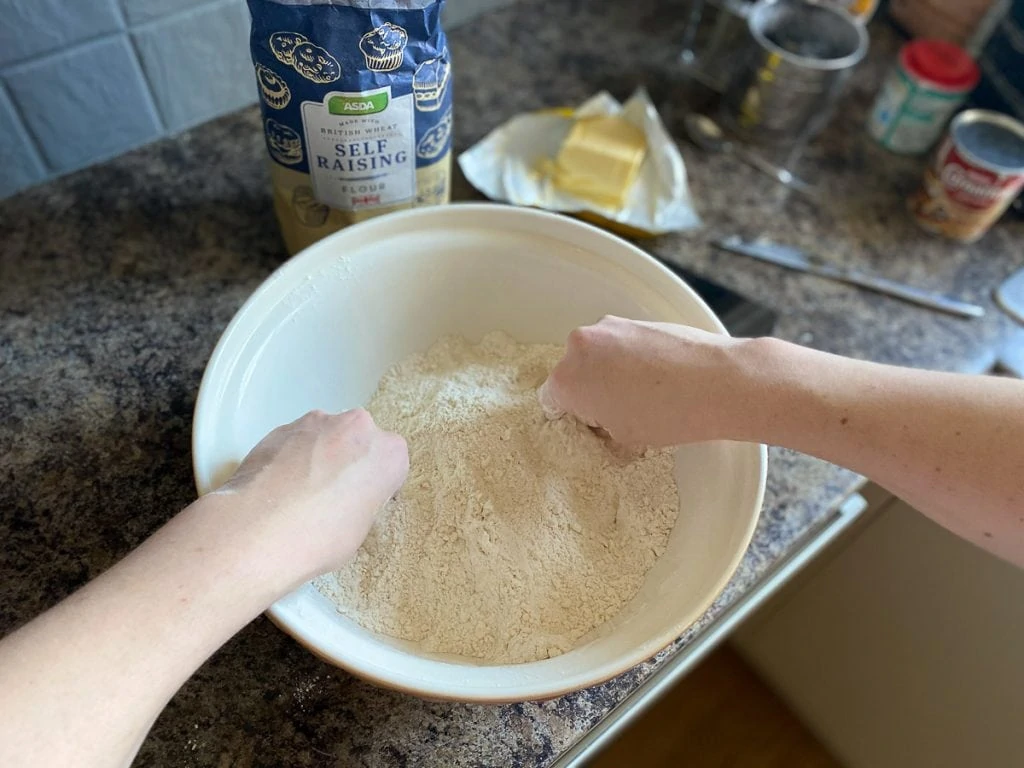
Rub the butter into the flour with your fingertips, and keep feeling around for any lumps. It should end up looking like a bit like breadcrumbs, like in the photo above.
You can add extras at this point if you like. Popular extra flavours include sultanas or grated cheese.
When adding the milk, some people use a knife, but my Grandma uses a fork. You can tip the milk in and then take the fork and sort of stir it up and try and pull it together. The mixture shouldn’t be too wet or too dry. It’s a bit of a fine line!
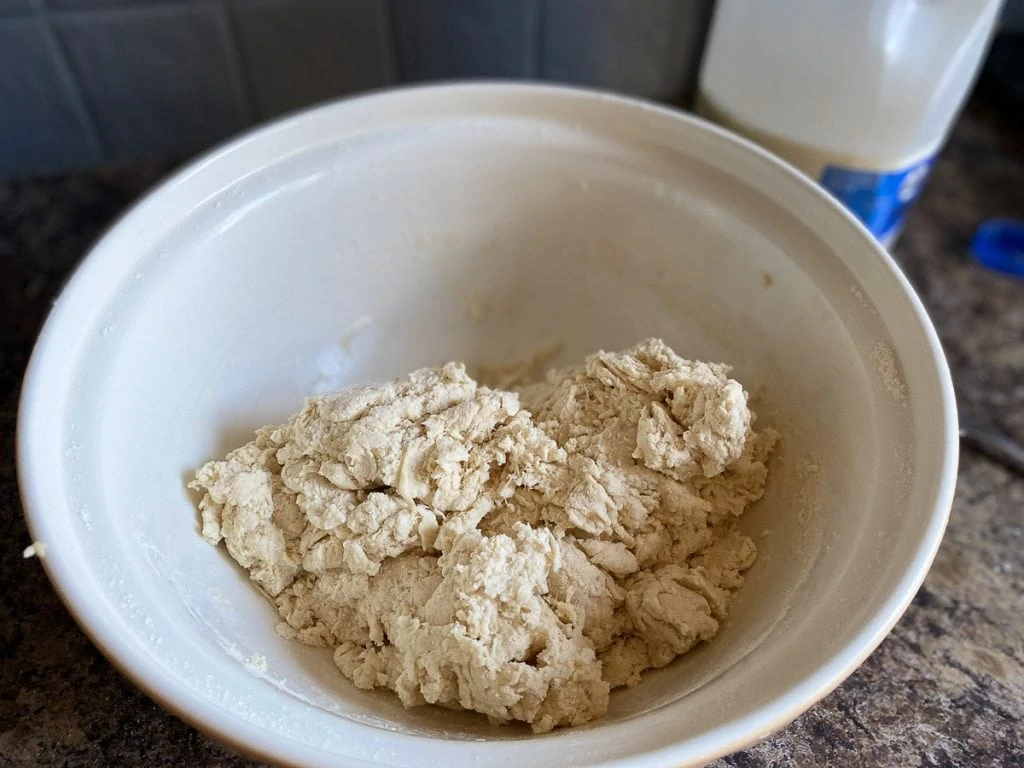
Once you’ve used the fork to try and bring it together, you might need to get your hands into the bowl too. Try only to use your fingertips to work some of the loose bits into the dough.
If the mixture gets really sticky, you may need to add a little more flour, or if it’s too dry and not coming together then gradually add more milk until it does.
You can work the dough a little more on a floured benchtop or mat, but you don’t want to overdo it! My Grandma definitely stressed the need only to use your fingers when working it together. You don’t need to knead it like bread.
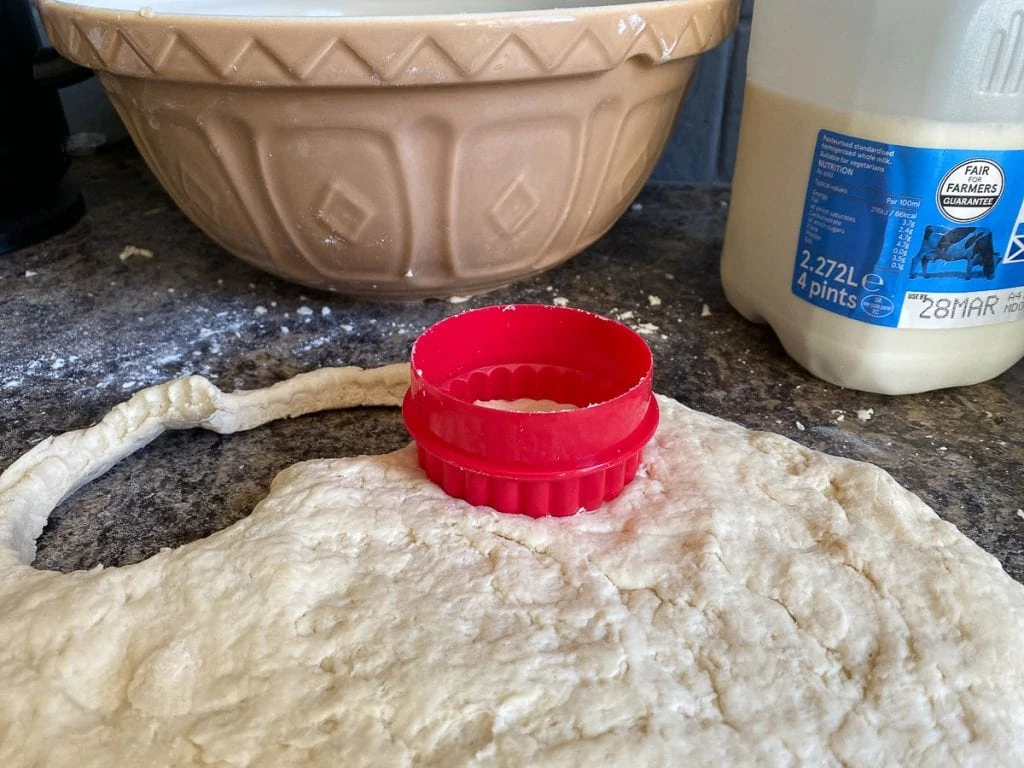
My Grandma had a similar metal cookie cutter like this that she always used for the scones, so to me, this is scone shape!
You can just cut the dough into squares or triangles though, or even use the rim of a glass dipped in flour then pushed down into the dough to make circle scones.
If you’ve made cheese scones you can top them with a little grated cheese too.
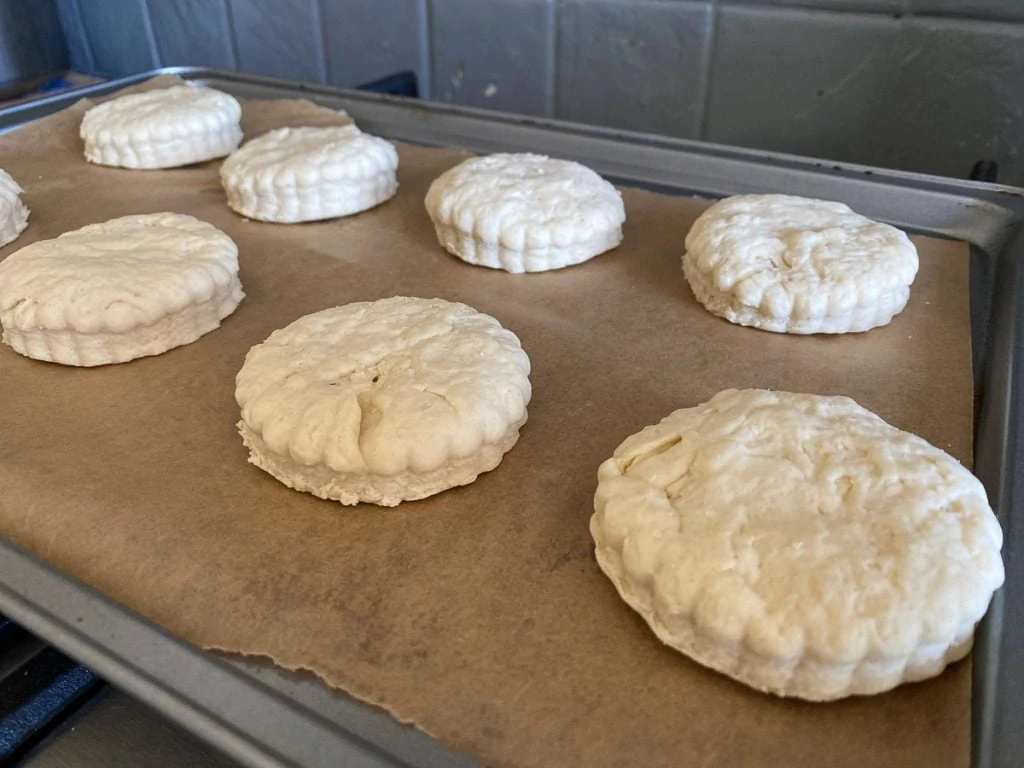
I brushed the top of these scones with some milk and baked them in a 200C fan oven for about 10 minutes.
There is some variation based on ovens and what temperature you go with, but I usually go about 200C with ours. You’ll get to know your oven, as my Grandma says!
Usually, I serve them with either butter and jam, or jam and cream. Clotted cream is the best!
This recipe made about 18. There always seems to be one little one at the end, no matter how much mixture you make!
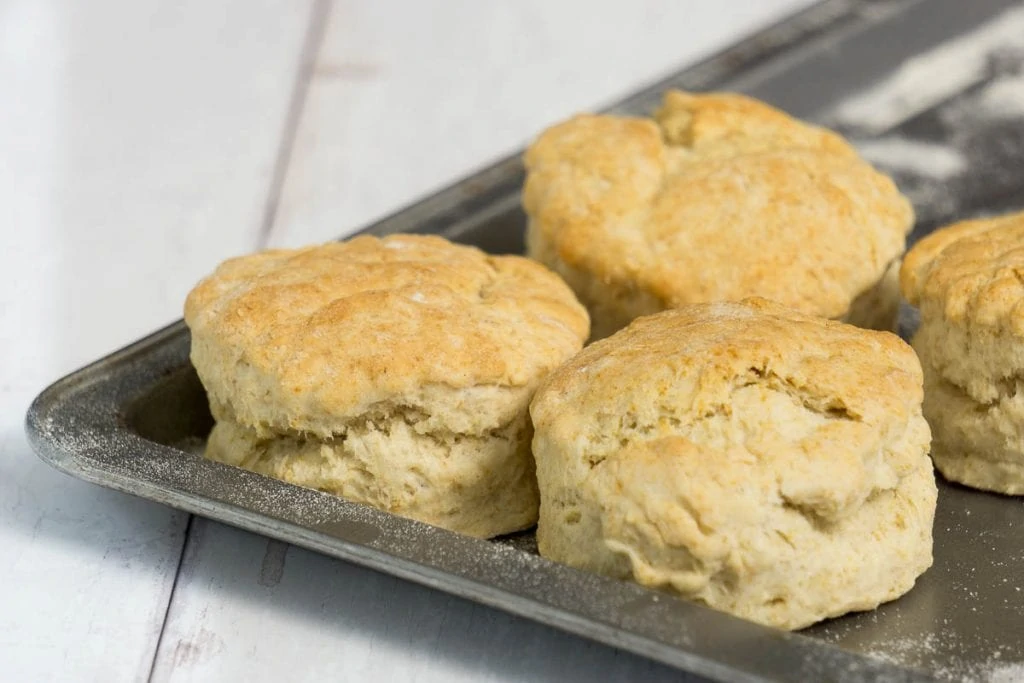
Can you freeze scones?
If that seems like a lot, you can actually freeze scones. Put them in a bag and squeeze out as much air as you can.
Of course, my Grandma had a special tool for getting the air out of bags too! I don’t even know if you can buy them anymore…
When you want to eat one from the freezer get it out and sit on the kitchen bench until thawed, it won’t take too long, or put in the microwave on 10-second blasts until it’s done. It’s always nice to reheat a little anyway!
Grandma's Scone Recipe
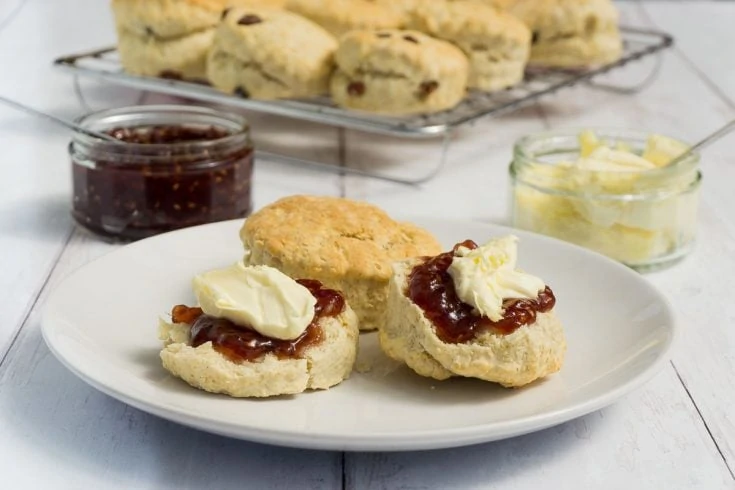
Use this easy scone recipe to make sweet or savoury scones! You can add in fruit, cheese, or other flavours to suit your taste, or make them plain.
Ingredients
- 500g self raising flour (4 cups)
- 4 tsp of baking powder (technically this is already in self-raising flour, but I usually add it anyway)
- 100g butter
- Approximately 350ml milk (1.5 cups)
Instructions
- Turn the oven to approximately 180C Fan/200C normal (350/390F)
- Sift flour and baking powder into a bowl
- Slice butter thinly or grate into the bowl
- Rub the butter into the flour with your fingers
- Add milk gradually and use a fork to bring the mixture together
- Tip onto a floured mat or benchtop
- Use your fingertips to bring together more and the flatten out
- Cut into even triangles or squares, or use a cookie cutter
- You can brush with milk or egg on the top if you like but not necessary
- Bake in the middle of the oven for approximately 10-15 minutes, depending on the heat of your oven. I usually do mine for around 12 minutes. Check the bottom of one is slightly browned which will tell you they're ready.
- Put on a wire rack to cool
- Store in an airtight container or wrap in a tea towel to keep them soft
Notes
Cooking time may vary depending on your oven and the size of the scones. They should feel light to pick up and be slightly browned on the top when done. This recipe makes around 18 scones, depending on size. You can freeze any leftovers!
Nutrition Information:
Yield:
18Serving Size:
1Amount Per Serving: Calories: 149Total Fat: 5gSaturated Fat: 3gTrans Fat: 0gUnsaturated Fat: 2gCholesterol: 14mgSodium: 486mgCarbohydrates: 22gFiber: 1gSugar: 0gProtein: 4g
The nutritional data in this recipe is provided by a third party and these values are automatically calculated and offered for guidance only. Their accuracy is not guaranteed.
And that’s my Grandma’s recipe for scones, made in Scotland!
Other Scone Recipes to Try
Sonja x

Plain scones with jam and cream, date, cheese and sultana are all delicious 🙂
I am going to try them! seem delicious! also thanks for the very good tips
Very much our pleasure, we hope you liked them!
Can’ t get clotted cream here in Canada. Poor us!! 😢
We have found a way to make it! Will post a recipe soon :D.
Hello – Did you ever post the clotted cream recipe? I searched the site and can’t find it. Thanks!
Hi Matthew, we didn’t because we tried numerous versions and created our own recipes. We just couldn’t get one that we were happy sharing. There are some excellent recipes on youtube, but for us they didn’t quite hit the mark enough, the same as our own versions. Sorry to disappoint!
I can’t wait to make clotted cream!
I’ve use this version for clotted cream. It’s pretty good and true to the taste compared to those made with sour cream and cream cheese. https://confessionsofabakingqueen.com/mock-clotted-cream/#tasty-recipes-32171-jump-target
She also has how to make clotted cream: https://confessionsofabakingqueen.com/clotted-cream/
Don’t twist the cutter when you are cutting out your scones as they tend to fall over. Also I use Raw Cane sugar -gives the scones a little crunch
Excellent tip Jill, we don’t twist either when we’re making scones, great minds! As for adding sugar… we’ll have to check with Grandma 😉
My scones come out different each time I make them so I will try your recipe next. How thick do you roll/pat out the dough?
We hope you like it! We roll our dough out to about an inch thick.
I’ve enjoyed your site this evening. I’ve printed a few recipes and will be trying them. Will let you know how they turned out for me.
-Rebecca, Arkansas USA
Hi Rebecca,
Thank you so much for letting us know, we hope your bakes turn out perfectly!
Excited about making these scones tomorrow.
Never made them before. Thank yiu so much gor the recipe.
Our pleasure, we hope they went well!
Thank you! Was very simple to make and came out delicious!
I was wondering, could I make this recipe with spelt flower?
That’s great! We’ve never tried it but from a little research it should be fine, just keep an eye on cooking time and you may need to add a little more baking powder as spelt flour is not self raising.
Hi, can I use wholemeal flour for this recipe? Thank you
We haven’t tried it with wholemeal flour because we want to get that “made by Grandma taste” but we don’t see why not, let us know how they turn out. Phil & Sonja
This is the same as my recipe… Basicly…. I just use self raising flour and if I’m doing cheese I add an out 1/2 teaspoon of salt (I do make big batch) I add a little suger to fruit scones and some cinnamon….. I just grate in the butter on the small side of the grater…. I’m a bit like your gran as I don’t measure its all by eye…. But I’ve been making these for over 50 years and they come out every time….. I’m also a Kiwi…. Any that I have left over the next day I cut in half and make kind of muni pizzas….. Yum….
Practice makes perfect! I hope to advance to be able to make it all by eye one day. But I need some more practice first! I’ve tried to get many recipe out of my grandma and it’s always difficult because she has no idea of the measurements haha. Making them into mini pizzas sounds yummy!
What kind of milk do you use? Fat free vs 2% etc? And do you use the milk at room temp?
Hi there, we have used both full fat and semi-skimmed (British milk types) After a quick google we’d say that 2% would prob be the closest to the milk we’ve used.
Made this recipe yesterday. In the US, scones are a secondary (albeit expensive) afterthough at local coffee shops and bakeries. They’re dry, hard, and flavorless. I used a pastry cutter to mix in the butter and flour. It took me no time at all, and it didn’t gum up the dough. It is indeed a dry dough. As luck would have it, I got the perfect texture on my first go. I had maybe two tablespoons of milk leftover. I also spooned and leveled my flour instead of scooping and leveling.
I don’t have a rolling pin, and I was worried about the butter melting. I pulled out my trusty meatloaf pan, floured the bottom and gently pushed down the dough into a rectangle. I don’t think I’ll ever use a rolling pin, honestly. The dough is too thick and fragile.
They got baked at 400F degrees for 15 minutes. beautifully, light golden brown and crusty tops, tender and slightly chewy centers. In America, clotted cream isn’t a thing. Apparently we only obsess over cream cheese….So out came the butter, jam, and Yorkshire tea.
I will officially be abusing your recipe pages for the next 60 days minimum. These scones have opened my eyes to something rather extraordinary. My renewed joy for exploration.
This is one of my favourite ever comments! Abuse and explore away, sir! – Phil
P.S You can find how to make clotted cream online, it is a must with Scones
I discovered scones on a visit to Scotland back in 1985. The inn keeper was kind enough to share her recipe with me and let me bake with her. Pretty much the same as yours. No sugar, no egg and minimal butter. As the inn keeper said to me, “the sweet and rich are added in toppings (clotted cream, preserves, etc.). American scones, in my opinion, are a ‘cake cookie’.
What an awesome story, Melody. Thank you for sharing. We’ll certainly be using the phrase ‘cake cookie’ in the future!
Oops sorry. Should’ve been ‘halved the recipe’.
Yes, I agree, NO sugar, NO egg, keep it simple & traditional Scottish scones. They are made here in Canada with sugar a well. The ones at the grocery store, in their bakery, are hard as rocks!! We can find the properly made ones at small bakery shops though. How lucky you were to bake with the Inn keeper.
I just made this this morning as a “sourdough “version. I have your recipe because it’s just me and my husband, so far I have a recipe I use 100 g of my sourdough discard. You can also use starter but it’s a great way to use up the discard. Then I just remove 50 g of flour and 50 g of the liquid. I ended up starting out with a half a cup of milk and remove the 50 g from that but I think next time I’m only gonna remove 40 g of the flour. The texture is a bit different but it’s really good.
Far too many adverts I tired of looking at them before I got to the ingredient list so I just scrolled to the bottom of the page where I found the comments section.
Many similar web sites have a “link” jump to recipe. Yours doesn’t.
You’ve popped quite angry comments on at least 5 other posts; the adverts can’t be upsetting you too much. We’re sorry you don’t like what we do or the fact we, as a family, are trying to make a living from it. That’s why sites have ads. You do have the choice to use whichever website you like of course and we’ll understand if you no longer choose to use ours.
These look delicious! What fruit and preserves did you use that’s pictured? Thank you so much! 🙂
Hello,
We used Mackays Scottish Strawberry preserve.
Just made 18 rather bland scones. Should there be sugar in the recipe? It’s not on the ingredients list on in the instructions. I was so hopeful too, having failed to get a scone to rise after many, many attempts. I’ll try again if you can let me know how much to add. Thanks.
These are as we’ve always made them, by all means add some sugar or fruit if you have a sweeter tooth. If that doesn’t work try our Paris buns or Treacle scones?
An Addition to my Cheese Scones.
I add half an onion chopped up finely and then sweated in a pan and I add that to my dry cheese scone mix .
I add 2 teaspoons of Whole Grain Mustard to the milk before I add it to the dry ingredients.
You also can add Cayenne Pepper or Mild Paprika by sprinkling it onto the top of the scones before baking them .
It adds a little twist to plain Cheese Scones 🤗
Thank you so much for this wonderful recipe but scones are so light and fluffy
Made some for Christmas presents and everyone loved them
I will always use this recipe for scones from now on
Thank you Scottish scran 😊
Biscuits have less butter than scones? My recipe has more butter than this, and less milk.
Interesting! I’m sure there are variations in recipes but that seemed to be the case of those I looked at.
HI! Is your recipe based on New Zealand or British self-raising flours? There are differences for the American market, particularly in terms on the amount of baking soda you added. Thanks.
This recipe refers to UK Self-raising flour, hope this helps
Thank you so much for sharing this recipe! I just made these in my new home in Scotland. They were absolutely superb! Extremely light and fluffy. I love the simplicity of the recipe (compared to the posh faffy celebrity chef type ones). It’s a very quick method, which I think helps the scones rise so well. No overworking the dough. The outcome is far superior to any I’ve baked yet. I had to leave them in the oven for nearly 20 mins so next time I’ll increase the oven temperature a little. I think I’ll add a little sugar too, but not too much, probably equal quantities to the butter. This is now my go to scone recipe and I can’t wait to try some of your other recipes. Thanks a million!
Just to add to my above comment. Yesterday I didn’t have jam so I ate them with just butter. Today I bought some strawberry jam (and lurpak!) and it makes all the difference! The perfect scone. Thank goodness I froze them or it’d be a full scale massacre! Thank you 😊
Just a note about US biscuits. Yes, biscuits and sausage gravy is a popular breakfast dish, especially in the south. We also eat biscuits with butter and jam or honey. Breakfast sandwiches are made with biscuits, egg, sausage, and cheese. Some people prefer ham or bacon to sausage. I’m partial to fried boneless chicken in my biscuit sandwich.
Hi. The reviews sound so positive and scones look delicious 😋 just need to make these. Please could you confirm thickness of dough and how large should the cutter be?
If I wished to add sultanas or currents how many grams approximately. Thank you for any advice. 👍👍👍
The thickness of the dough really depends on your desired size of scone. The ones in the pictures are a little smaller but if you wanted chunkier ones then about an inch thick.
Again the cutter depends on how big you want your scones to be, our is a cutter that’s 3.5 inches across give or take. The thicker your scone will affect the cooking time on, so just keep an eye on them when they’re in the oven.
Thank you for sharing your grandma’s scone recipe! It brings back so many fond memories of my own grandmother baking in the kitchen. I can’t wait to try this recipe and recreate those delicious flavors. The tips on achieving the perfect texture are especially helpful!
I loved this post! Your grandma’s scone recipe brings back so many memories of family gatherings. I can’t wait to try it out myself! Thank you for sharing such a cherished recipe!
I made my first scones and the recipe I used had me form the dough into one big round and cut them into wedges after they were baked. I even saw wedge shaped scone pans on the internet. What are you thoughts on the shape of these yummy things? I live in the southern USA and when we make our biscuit version of scones, we make them individual rounds. The shape doesn’t really matter to me unless it effects the outcome of the baking. Just wondering your thoughts.
If they taste nice and you’re happy then we say make them whatever shape you prefer.
I can’t wait to try this scone recipe! My grandma used to make similar ones, and I have such fond memories of enjoying them with tea. Thank you for sharing!
Maybe good, but definitely not Grandma’s recipe. Fairly certain they she didn’t use self rising flour.
We may be talking about different Grandmas, Sonja’s most certainly did.